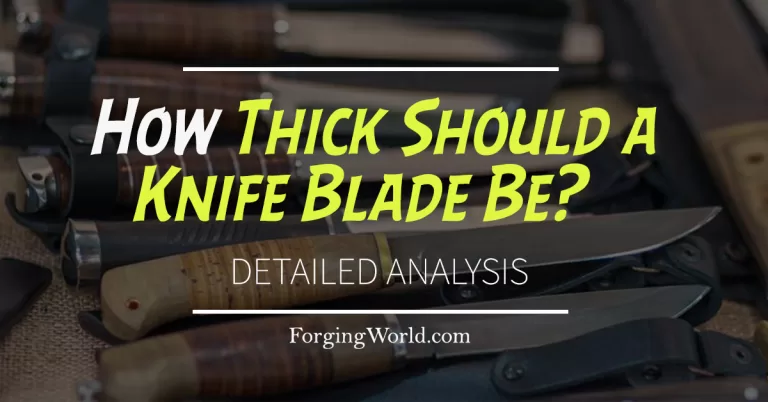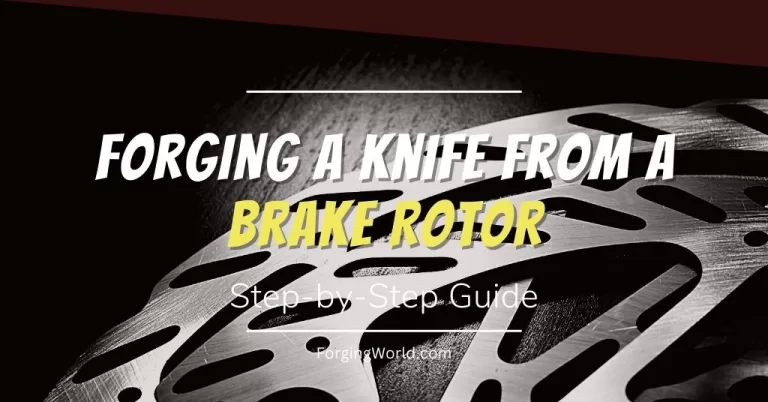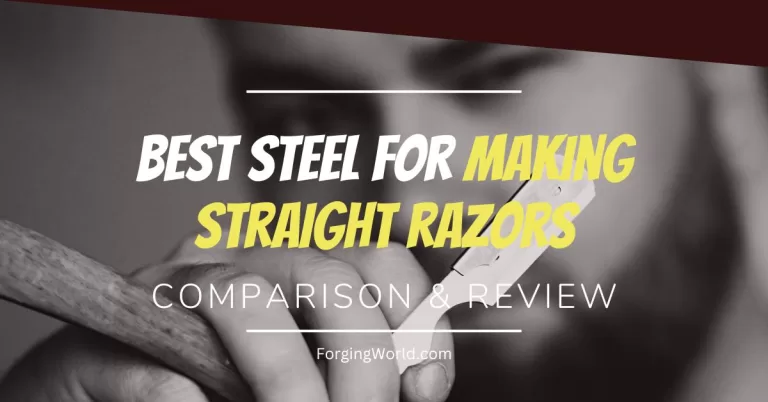Are you searching for the perfect hammer to take your knife-making skills to the next level? You’ve come to the right place!
In this article, we’ll delve deep into the best hammers for making knives, tailored to your skill level. We’ll discuss various types of hammers, their pros and cons, and what makes them the top choice for forging knives.
So, grab your apron, and let’s start hammering!
What is the Best Overall Hammer for Knife Making?
A cross-peen hammer is generally considered one of the most popular hammers for knife making. It is an extremely versatile hammer and it also allows aggressive drawing out. For most people, a 2-3 pound hammer is typically recommended. Note that, the heavier the hammer is, the harder is to control it.
Best Hammers for Knife Making
There’s a wide variety of hammers that can be used for knife making. Let’s take a closer look at some of the most popular choices and what each type is best for:
1. Cross Peen Hammer (Best for General Forging and Drawing Out Metal)
The cross peen hammer is a versatile tool and a favorite among blacksmiths. Its flat face is perfect for general forging, while the peen (the narrow, wedge-shaped end) is great for spreading and drawing out metal.
Best for: The cross peen hammer is particularly suitable for drawing out material perpendicular to the hammer’s handle. This makes it ideal for creating tapers and fullers in knife blades.
For a top-quality cross peen hammer, we recommend the Peddinghaus cross peen hammer.
Learn more about the cross peen hammer techniques and how to use this versatile hammer effectively.
2. Straight Peen Hammer (Best for Forging Long, Straight Blades)
The straight peen hammer has a similar design to the cross peen but with the peen running parallel to the handle. This design is particularly useful for forging long, straight blades, as it allows you to work along the length of the blade with ease.
Best for: This hammer is particularly useful for forging long, straight blades or creating fullers parallel to the handle. The straight peen allows for more precise control when working on details in your blade.
We recommend the Picard straight peen hammer for its excellent quality and durability.
Learn more about the straight peen hammer and its uses in knife making.
3. Rounding Hammer (Best for Precise, Controlled Blows)
The rounding hammer has one flat face for general forging and a rounded face for fuller, more controlled blows.
Best for: The rounding hammer is a popular choice for bladesmiths because it provides excellent control and precision when forging bevels and other curved surfaces on knives. The rounded face allows for a smoother transition between hammer blows, reducing the need for extensive grinding and polishing.
For a top-notch rounding hammer, consider the Hofi-style rounding hammer by Brent Bailey Forge.
Discover more about the rounding hammer and its benefits in knife making.
4. Ball Peen Hammer (Best for Peening and Shaping Metal)
While not specifically designed for knife making, the ball peen hammer can still be useful in certain situations. The round end can be used for peening and shaping metal, while the flat face is suitable for general forging tasks.
Best for: The ball peen hammer is ideal for tasks that require more delicate shaping or peening of the knife, such as creating decorative elements or finishing the blade. It’s also useful for tasks like riveting and texturing.
We recommend the Estwing ball peen hammer for its superior quality and comfortable grip.
Learn how to use the ball peen hammer effectively in your projects.
5. Dog Head Hammer (Best for Japanese-style Bladesmithing)
The Dog Head Hammer, also known as a Japanese dog head hammer, is a specialized hammer used primarily for forging blades in traditional Japanese bladesmithing.
Best for: The hammer’s unique design, with a one-sided flat face and a long handle, allows for precise control and efficient energy transfer when forging blades. This hammer is ideal for those looking to make Japanese-style knives, such as katanas and tantos.
6. Diagonal Peen Hammer (Best for Drawing Out Material Diagonally)
The Diagonal Peen Hammer is similar to the cross and straight peen hammers, but with a peen that is angled diagonally. This design allows blacksmiths to draw out material in a diagonal direction, creating unique textures and shapes in the metal.
Best for: The Diagonal Peen Hammer is excellent for knife making projects that require more unconventional shapes or for adding a distinct touch to your work.
We recommend the Picard Diagonal Peen Hammer for its top-notch quality and durability.
| Hammer Type | Good For |
|---|---|
| Cross Peen Hammer | Drawing out material, spreading metal, creating texture, precise control, and versatility |
| Straight Peen Hammer | Drawing out material in a specific direction, shaping metal, creating texture, and control |
| Rounding Hammer | Moving metal quickly, forging blades, and general-purpose blacksmithing tasks |
| Ball Peen Hammer | Peening, texturing, riveting, and shaping metal; great for beginners and versatile for various tasks |
| Dog Head Hammer | Blade forging, Japanese-style bladesmithing, and precise control |
| Diagonal Peen Hammer | Drawing out material in diagonal direction, shaping metal, and creating texture |
Don’t forget to explore the various hammer types and find the one that suits your knife making needs the best. Remember, the perfect hammer for you will depend on your personal preferences and the specific tasks you need to accomplish in your knife making projects.
How to Choose the Right Hammer for Knife Making
When selecting the best hammer for knife making, consider the following factors:
Weight: Striking the Right Balance
A heavier hammer allows for more powerful blows, but it may be more challenging to control, especially for beginners. Start with a lighter hammer and gradually increase the weight as you gain experience and control.
Keep in mind that using a hammer that’s too heavy for you can lead to fatigue and reduced precision, while a hammer that’s too light may require more effort to achieve the desired results.
Handle: Comfort and Control
The handle’s material, length, and shape can impact your comfort and control during forging.
Consider the following aspects when choosing a handle:
- Material: Wooden handles are traditional and absorb shock well, while fiberglass and steel handles are more durable and require less maintenance.
- Length: The length of the handle should provide you with a comfortable grip and enough leverage for efficient hammering. Experiment with different handle lengths to find what works best for you.
- Shape: Some handles have ergonomic designs or unique shapes to improve grip and reduce fatigue. Custom hammer handles can be tailored to your preferences for optimal performance.
Face and Peen: Suiting Your Needs
Consider the type of work you’ll be doing and choose a hammer with a face and peen that best suits your needs. Familiarize yourself with the hammer anatomy to better understand your options.
For example, a cross peen hammer is excellent for drawing out metal, while a rounding hammer provides precise control for shaping and forming.
Brand and Quality: Investing in Durability and Performance
Invest in a high-quality hammer from a reputable brand to ensure durability and performance.
Check out our list of the best brands for blacksmithing hammers for recommendations.
While a high-quality hammer may be more expensive upfront, it will likely last longer and provide better performance over time, making it a worthwhile investment.
Personal Preference: Finding the Right Fit
Remember, the right hammer for you may not be the same as the right hammer for someone else. It’s essential to try out different hammers and choose one that feels comfortable and suits your style of work.
Reach out to fellow blacksmiths and bladesmiths for recommendations, and if possible, test out different hammers at workshops or classes to find the perfect fit.
Frequently Asked Questions
While it’s possible to use a regular hammer, it’s not ideal. Blacksmithing hammers are specifically designed for forging and shaping metal. Using a hammer designed for knife making will provide better control, precision, and efficiency.
The ideal weight varies depending on your skill level and personal preference. Beginners should start with a lighter hammer (1.5 to 2 pounds) for better control and gradually increase the weight as they gain experience. More experienced smiths may prefer heavier hammers (2 to 4 pounds) for more efficient forging.
Yes, you can forge your own hammer for knife making. This can be a rewarding project that allows you to create a custom hammer tailored to your preferences.
Proper maintenance is essential for prolonging the life of your hammer. This includes regular cleaning, inspecting for damage, and replacing the handle when needed.
Check out our guide on how to clean and maintain a ball peen hammer for more information.
The best handle material depends on personal preference. Wooden handles are traditional and absorb shock well, while fiberglass and steel handles are more durable and require less maintenance. The handle’s length and shape should provide comfort and control during forging.
Final Thoughts
Choosing the right hammer for knife making is an essential step in achieving optimal results in your blacksmithing and bladesmithing projects.
By understanding the unique benefits of each hammer type and considering factors like weight, handle, face and peen, brand and quality, and personal preference, you’ll be well-equipped to make an informed decision.
Keep experimenting and learning from fellow smiths, and don’t be afraid to try new hammers as your skills and needs evolve.



